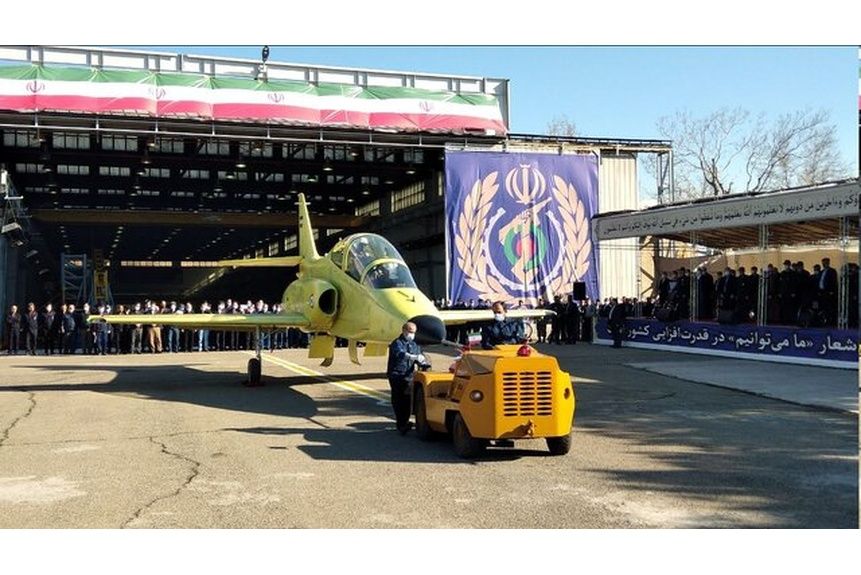
Iran Unveils Updated Yasin Training Jet With Possible Close Combat Applications
By Michael Rubin
In 2019 the Iranian military unveiled its new Yasin Training Jet [GRLCUT(1] to great fanfare. In March 2023, Iran announced the final prototype and Yasin production line, according to the excerpted article from the semi-official, pro-government Iranian Students’ News Agency. The latest variation of the training aircraft is said to include many upgrades, including new ejection seats, avionics, engine, and landing gear.

The Yasin training jet, 11 March 2023.
“The Yasin will be able to be used… for close air support.”
In 2019 the Iranian military unveiled its new Yasin Training Jet [GRLCUT(1] to great fanfare. In March 2023, Iran announced the final prototype and Yasin production line, according to the excerpted article from the semi-official, pro-government Iranian Students’ News Agency. The latest variation of the training aircraft is said to include many upgrades, including new ejection seats, avionics, engine, and landing gear. An Iran-produced airborne weather radar has also been fitted into the Yasin. According to the article, since the end of the Iran-Iraq War, pilot training was put “on the agenda” of the Armed Forces, but Iran has continued to suffer from an aging fleet and untrained pilots.[i] The article suggests that pilot training is paramount in the development of the Yasin,[ii] but there is also speculation that Iran may fit the aircraft with weaponry, allowing it to become a low-cost, easy-to-operate, multi-role fighter with a focus on close air support. If Iran can produce the Yasin at scale, not only would it be a valuable training platform, but it could also be deployed to many of the conflict zones in which Iran has previously relied on drones for air support—namely Lebanon, Syria, Iraq, and Yemen. The introduction of the Yasin, or any Iranian manned aircraft, into any of these conflicts would risk escalating these proxy wars further.
Source:
“Ravanma-ye az Namuneh Ma’yar Tawlid-e Jet-e Amuzesh-e ‘Yasin’ (Unveiling of the Training Jet Prototype ‘Yasin’),” Iranian Students’ News Agency (semi-official student-run news agency that promotes the Iranian government’s line), 11 March 2023. https://www.isna.ir/news/1401122013717
The Yasin’s training jet production prototype was unveiled in the presence of the Minister of Defense and Armed Forces Logistics, while the mass production line of this training jet was also inaugurated…. Pilot training is one of the most advanced and complex training regimens that any country can do. The Islamic Republic of Iran has succeeded in applying world-class education in the fields of science and technology, and training pilots is no exception.
After the end of the [Iran-Iraq] war, the necessity for pilot training was put on the agenda of the Armed Forces. From that time, with the input of veterans and professors, faculties for training pilots were created….
So, how does the Islamic Republic of Iran train pilots and what is the role of Yassin training jet?
The training of the fighter aircraft pilot is fundamentally different from the civilian pilot. For military pilots, training is done in three stages: First, basic training for learning flight basics. Second, training for flight skills, regulations and maneuver. And, third, advanced training for tactical flight ability with advanced fighters. An important feature of advanced training jets is that pilots from operational bases continue to exploit them, and pilots become familiar with air combat and ground combat tactics and techniques, and learn the use of various weapons. All of these advantages and features have been the reason for…the Ministry of Defense to design and build this aircraft.
Does the aircraft also have combat capability?
Since combat training is in many cases carried out with real weapons and in simulated battle environments, it is natural that Yasin jet has the capability to conduct combat missions as well. In the development plan, it will be able to be used as a light combat aircraft and for close air support.
Notes:
[i] For background on efforts within Iran to re-equip its air force, see: Michael Rubin, “Iran-China Air Force Cooperation on Horizon?” OE Watch, December 2015. https://community.apan.org/wg/tradoc-g2/fmso/m/oe-watch-past-issues/195975/download See also: Michael Rubin, “Iranian F-14 Crash Highlights Iran’s Need for New Fighter Contract,” OE Watch, August 2022. https://community.apan.org/wg/tradoc-g2/fmso/m/oe-watch-past-issues/421643/download
[ii] While a potentially positive step for the Iranian Air Force, the Yasin is not the bridge trainer required for Iran’s recent purchase of the Su-35 multi-role fighters from Russia. The Su-35 is far too complex and would necessitate a more advanced trainer. It is more likely that Russian pilots will train Iranian pilots to fly the Su-35.
Image Information:
Image: The Yasin training jet, 11 March 2023.
Source: https://cdn.isna.ir/d/2023/03/11/3/62547091.jpg?ts=1678512083735
Attribution: Iranian Students’ News Agency
Distribution A: Approved for public release
Categories:
Tags:







